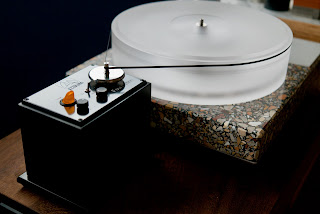A flywheel can benefit rotational stability and using one with a turntable is a natural application. Adding size and weight to the motor pulley does a couple of things with no penalty. First, it lessens the amplitude of any motor generated vibration. Second, due to its high RPM, the small mass is has greater effect than it would seem. There is also no added noise of a second bearing and drive mechanism, belt etc... as a separate flywheel would require.
It took three versions to refine the concept into production.
The old pulley...
... and the new one.
After years of trials with tapes and threads, including, silk, linen, nylon, polyester, 1/8" and 1/4" audio tape, holographic party ribbon, kapton etc..., the easy winners are polyester thread and a lightweight, precisely made, fabric belt. This has no stretch and plenty of traction.
The Pulley is setup for both thread and belt.
Verifying with numbers is helpful. Here we have a wow and flutter measurement less than 0.1% which is getting into direct drive territory..
The numbers indicate stable rotation but they do not tell us how it sounds, how it compensates for load variation. This influences the sound significantly and the numbers do not speak to this.
As a refinement of tuned setup the differences were readily apparent sonically.
I will attempt to be neither coy nor enthusiastic. The music flows with greater authority and greater ease at the same time. When big things happen they they happen big and when they are over the space around them in the decay is well depicted. The decays themselves are extended and layered.
It took two years with three versions of prototypes to reach this performance and now it is ready to to be offered as an upgrade to our customers. Please inquire via email.
Next up are the motors experimented with and sonic impressions of each as well as a little detail of the motor controller developed with pure analogue speed control of a DC motor.










No comments:
Post a Comment
Note: only a member of this blog may post a comment.